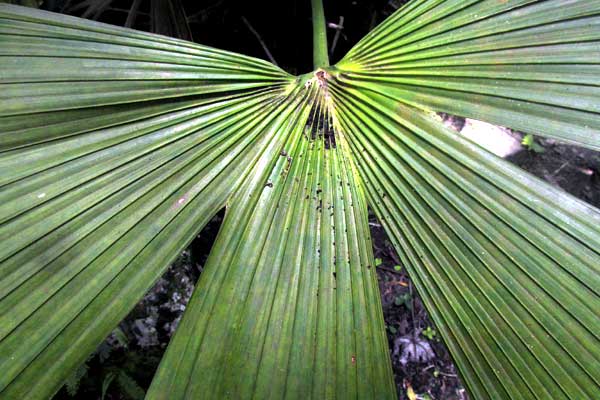Excerpts from Jim Conrad's
Naturalist Newsletter
from the November 9, 2018 Newsletter with notes from a camping trip into northern Guatemala's Petén department
ROOTSPINE PALM
A month ago, on October 2 when I was camping on the eastern side of the town of Sayaxché, in Rosario National Park in northern Guatemala's Petén district, I set my tent up beside the clump of fan-palms seen below:

The palms were neither flowering nor fruiting, but their fronds were so unusual that maybe I could identify the species solely on their appearance. Below,you can see an important peculiarity of the fronds in a close-up of a frond blade's base, where it attaches to its petiole:

One curious feature is that the fronds are for the most part divided into many slender segments, but as the segments approach their points of attachment with the petiole they unite into a very few units-- five or so.
Another unusual fieldmark is that for a short distance the frond's petiole for a shorts distance continues as a kind of midrib into the blade body, with segments branching off its side. This petiole continuing as a midrib qualifies the palm as a "costapalmate" species, which the vast majority of palms are not.
These two features lead me to CRYOSOPHILA STAURACANTHA, sometimes known as the Rootspine Palm. It's endemic just to southeastern Mexico, Belize and Guatemala. Earlier the binomial was thought to be Cryosophila argentea, but the authoritative PalmPedia.Net page for the species regards that an outdated name, a synonym. The common English name of Rootspine relates to the palm's trunks being covered with spine-like modified roots that keep away animals.
The palm in our picture has no trunk, so it's a young one. On the Internet, trunkless Rootspines looking like ours can be found, as well as those with very well developed, tall, slender stems bearing formidable spines on their bases.